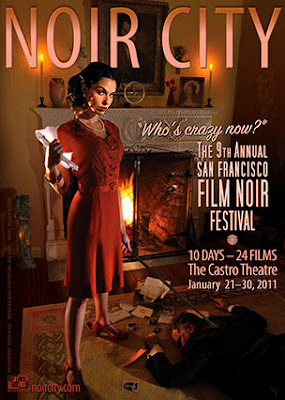The 2010 Noir City Film Festival closed on January 30. I saw 19 of the 24 films that were screened. Of the five I missed, I had seen three of them previously and the fourth film (Gaslight), I had seen on television. The film I hadn't seen or even heard of before was Strangers in the Night (1944).
2011 Noir City Films
High Wall starring Robert Taylor and Audrey Totter; (1947)
Stranger on the Third Floor with Peter Lorre; (1940)
They Won't Believe Me starring Robert Young and Susan Hayward; (1947)
Don't Bother to Knock starring Richard Widmark, Marilyn Monroe & Anne Bancroft; (1952)
A Double Life starring Ronald Coleman; directed by George Cukor; (1947)
Among the Living starring Albert Dekker & Susan Hayward; (1941)
The Lady Gambles starring Barbara Stanwyck; (1949)
Sorry, Wrong Number starring Barbara Stanwyck and Burt Lancaster; directed by Anatole Litvak; (1948)
Crack-Up starring Pat O'Brien; (1947)
The Woman on the Beach starring Robert Ryan, Joan Bennett & Charles Bickford; directed by Jean Renoir; (1947)
Beware My Lovely starring Ida Lupino and Robert Ryan; (1952)
The Two Mrs. Carrolls starring Humphrey Bogart and Barbara Stanwyck; (1947)
Crashout starring William Bendix; (1955)
Loophole starring Barry Sullivan & Charles McGraw; (1954)
Blind Alley starring Chester Morris & Ralph Bellamy; (1939)
Secret Beyond the Door starring Michael Redgrave and Joan Bennett; directed by Fritz Lang; (1948)
The Strange Affair of Uncle Harry starring George Sanders and Geraldine Fitzgerald; directed by Robert Siodmak; (1945)
Angel Face starring Robert Mitchum & Jean Simmons; directed by Otto Preminger; (1952)
The Hunted starring Preston Foster & Belita; (1948)
§§§
There were a number of short films before some of the features. Serena Bramble made another short film. You may recall, she edited Endless Night: A Valentine to Film Noir which screened at last year's Noir City. This year, they screened her short film San Francisco is the Scene of a Perfect Crime. Eddie Muller has a credit at the end as producer, I believe.
§§§
I'll also add that the 2011 Miss Noir City, Angela Rocconi (aka Leslie Bone Rock Girl on 107.7 FM The Bone) was the most polished spokemodel Noir City has had since I have started attending. She was a very accomplished public speaker and knew how to play up her feminine charms for the crowd.
A few more items before I talk about the films. There were fewer on-stage interviews than in prior years. Stranger on the Third Floor co-starred Margaret Tallichet who was married to director William Wyler. Tallichet's daughter (Judy Wyler Sheldon), who is a San Franciso resident and was present at last year's Silent Film Festival, introduced the film.
Alan Rode (pronounced row-dee) who is on the Board of the Film Noir Foundation and runs the Palm Spring Film Noir Festival introduced a few films during the matinee performances.
The crowds were healthy but I thought slightly down from last year.
§§§
On to the films...I thought the line-up was a little weak this year although it improved greatly over the last three days of the festival. The theme was "Who's Crazy Now?" and featured villains and victims who suffered from mental instability or at least neuroses which ruined their lives or the lives of others.
The standouts were They Won't Believe Me, The Lady Gambles, Sorry, Wrong Number, Loophole and Angel Face. Still interesting but a half-step behind were The Woman on the Beach, Crashout and Secret Beyond the Door.
The rest of the films had their moments but I was decidedly mild towards them. In fact, I dozed off on a number of films this year, even during matinees. Perhaps, I've seen too many films or too many noirs in particular.
My favorite was The Lady Gambles which featured a bravura performance by Barbara Stanwyck as a woman who discovers she has a gambling problem on her first trip to Las Vegas. Her marriage and life are ruined as she sinks ever deeper to satisfy her gambling addiction. My favorite part is when various men hold the dice to her mouth and ask her to "kiss them for good luck." The blatanly Freudian and so effective. I'm beginning to look for clues in these Golden Age films where the filmmakers try to push the production code. In this case, Stanwyck's character's sexual repression is given release in her wanton gambling.
Ironically, The Lady Gambles was the only "film" screened from a DVD. Czar of Noir Eddie Muller put to a vote whether or not a print of The Lady Gambles should be restored with Film Noir Foundation funds. The vote was unanimously in favor.
A close runner-up was Angel Face which featured a damaged Jean Simmons who hates her stepmother and eventually resorts to murder to rid herself of her. Robert Mitchum plays the chump with more style than anyone else. However, Simmons is absolutely feral as she manipulates Mitchum, Mitchum's girlfriend, her father and everyone else. The frightening part is that she doesn't even really know what she wants but she is willing to kill for it. Again, I detected a hint of the forbidden. I think Simmons' character and her father were having an incestuous relationship based on their conversation during a chess match. Regardless, Simmons strikes pose after pose as she murders or tries to murder. That look alone is classic.
They Won't Believe Me is more memorable for the amorality of the lead character played by Robert Young. Having not one but two extramarital affairs and benefitting from not one but two deaths of women who loved him, Young is positively sociopathic as he fulfills his sex addiction.
Loophole was notable for Charles McGraw chewing up the scenery as the single minded insurance investigator hassling Barry Sullivan, an innocent bank teller accused of stealing $49,900 from his employer. With hints of Les Misérable, Loophole is a thinly veiled criticism of the methods and practices of HUAC. McGraw gets knocked unconscious and doesn't rough anyone up but he is at his most intimidating as man with the single minded pursuit of breaking down Barry Sullivan will so he will slip up and reveal where the money is.
Finally, Sorry, Wrong Number is a classic noir about a bedridden woman who overhears a phone conversation of what turns out to be her own murder. Once again Stanwyck delivers a great performance - ambitious and bitchy college co-ed, domineering wife to Burt Lancaster and frightened invalid. Although Lancaster is solid in his role, his main purpose is to provide a foil for Stanwyck to play off of.
The Woman on the Beach (directed by Jean Renoir) and Secret Beyond the Door (directed by Fritz Lang) was heavy on symbolism and I could benefit from repeat screening of both films. Woman on the Beach was anchored by a tremendous supporting performance by Charles Bickford as a blind (or is he?) artist. Secret Beyond the Door allowed Joan Bennett to show her acting chops by taking a walk on the wild side of her psyche. Death fascinates her and that's a good thing because her new husband (Michael Redgrave) likes to recreate murder scenes...and he is building a recreation of her bedroom.
Crashout is about a bunch of tough guys who break out of prison. William Bendix is the toughest of the tough and leads the bunch to their ultimate doom but not before wreaks havoc on as many people as possible. The film is one-dimensional but depicts hyperstylized sense of masculine malevolence.
Stranger on the Third Floor was notable for early performances by Peter Lorre and Elisha Cook, Jr. It also featured a dream sequence that was better suited to a German Expressionist film but would eventually become cliche.
Of the three Belita films I've seen in the past 18 months, The Hunted is the best. Belita has this noticeable scar on the left side of her face. I wish they would have incorporated it into the plot.
Blind Alley reminded me of a second-rate Hitchcock film but was reasonably interesting. Stars Chester Morris and Ralph Bellamy played their parts satisfactorily enough to keep me awake until the last few minutes.
2 weeks ago





